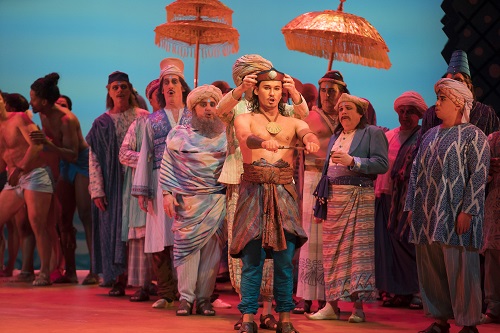 United States Bizet, Les Pêcheurs de Perles: Soloists, Lyric Opera of Chicago / Sir Andrew Davis (conductor), Chicago. 25.11.2017. (JLZ)
United States Bizet, Les Pêcheurs de Perles: Soloists, Lyric Opera of Chicago / Sir Andrew Davis (conductor), Chicago. 25.11.2017. (JLZ)

Cast:
Leïla – Marina Rebeka
Nadir – Matthew Polenzani
Zurga – Mariusz Kwiecień
Nourabad – Andrea Silvestrelli
Production:
Conductor – Sir Andrew Davis
Director – Andrew Sinclair
Set & Costume Designer – Zandra Rhodes
Lighting Designer – Ron Vodicka
Chorus Master – Michael Black
Choreographer – John Malashock
The revival of Bizet’s Les Pêcheurs de Perles (1863) for Chicago Lyric Opera treated audiences to a vivid setting by designer Zandra Rhodes. Originally created in 2004 for the San Diego Opera, the staging adapted well to Chicago’s Civic Opera House, and offered director Andrew Sinclair many opportunities for effective staging. Most of all, the musical execution was superb, with the three principals, soprano Marina Rebeka (Leïla), Matthew Polenzani (Nadir) and Mariusz Kwiecień (Zurga) at their finest, both in solos and ensembles.
Rebeka’s rich voice and warm colors gave Leïla nuances other artists can miss, especially in her opening aria (‘Dans le ciel’). Her clarity, exemplary style, and attention to the score drew rapt attention from the audience. She also added subtle touches, as in the sustained piano at the end of the line ‘Et mon chant léger, ainsi qu’un oiseau semble voltiger’ (and my delicate song seems to hover like a bird). Rebeka was particularly moving at the opening of the third act, pleading for Nadir’s life and inciting Zurga’s jealousy. Dramatically defiant, she was also vocally powerful when she cursed Zurga and vowed her eternal love for Nadir (‘Et je l’aime à jamais!’).
Polenzani was a captivating Nadir, with a sweet, round sound, especially in his unforced navigation of his higher registers. The famous duet in the first act had a fresh, stylish fervor, and he enhanced the narrative by with effective gestures, plus a gradual increase in volume and tempo. In a similar way, his monologue in the temple (‘Je crois entendre encore’), as Nadir realizes that the veiled priestess is actually Leïla, was sensitive in gradually realizes that the veiled priestess is actually Leïla, was sensitive in gradually revealing the character’s convictions.
As Zurga, Kwiecień was dramatically convincing and showed vocal splendor. His even tone resonated well, especially in the first-act duet, which was note-perfect and riveting, and in more declamatory passages, he showed firm command of the arioso-like passages. In Act III, the exchange with Leïla had admirable and poignant dramatic tension.
The climax came in the finale of Act II, when Zurga realizes that Nadir has actually broken the vow of friendship by attempting to woo Leïla. Kwiecień then opened the third act with remarkably sustained passion in the monologue (‘Moi seul j’appelle en vain’). Never meandering in pitch or tone, he brought out Zurga’s power and frailty with consummate finesse, adding dramatic pathos to the tragic ending.
The excellent chorus, spread across the stage to accommodate the choreography, deployed clear diction and rhythmic precision, singing as one. That same balance was evident in the orchestra, as Sir Andrew Davis brought sublety, richness, and color, in a well-thought-out interpretation that made the composer’s thematic structure evident.
Rhodes’s bold, colorful designs meshed beautifully with the score and reinforced the story. Her images drew from traditional pearl fishing in Sri Lanka, including the characteristic stilts that appeared in various guises, such as the scrim paintings that preceded each act. Choreographer John Malashock’s dance sequences—especially in the first and third acts—added another intriguing dimension, and the dancers executed his ideas with appropriate vigor.
James L. Zychowicz